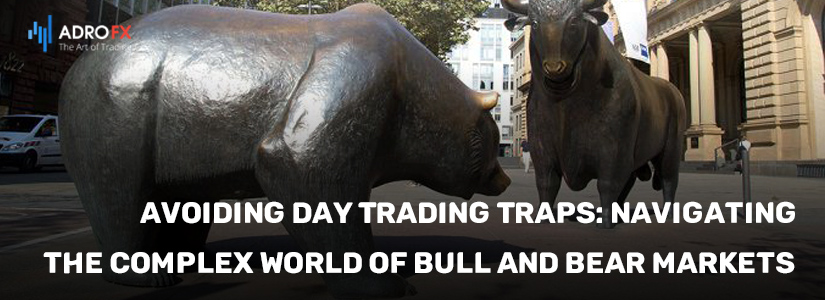Avoiding Day Trading Traps: Navigating the Complex World of Bull and Bear Markets

Day trading offers an enticing avenue for online income generation with low entry barriers, catering to both full-time and part-time engagement. The capital required to kickstart day trading is relatively modest. However, it's a complex endeavor, explaining why many aspirants falter. Common culprits behind trading losses include insufficient analysis, unfavorable luck, and psychological factors.
In this article, we delve into the prevalent pitfalls leading to market losses, classifying them into two categories: bull traps and bear traps, rooted in the fundamental concepts of bull and bear markets.
Decoding Day Trading: Bull Traps, Bear Traps, and Psychological Pitfalls
In the realm of day trading, understanding the intricacies of market dynamics is paramount for success. Below, we will explore the intricate world of day trading, dissecting bull traps and bear traps while shedding light on the psychological pitfalls that can ensnare even the most seasoned traders.
Bull Traps
A bull trap unfolds when a stock's price, which has been on a downtrend, suddenly reverses and begins to rise. However, this ascent is typically short-lived, as a rush of buyers floods in. The influx of buyers soon outpaces sellers, causing the stock's value to plummet. To identify a genuinely upward-trending stock, seek one that starts the day in the lowest price bracket and concludes in the top tier. A stock that consistently climbs throughout the day typically signifies a robust and reliable trend.
Bear Traps
Conversely, a bear trap occurs when a stock's price initiates a decline, prompting nervous traders to offload their holdings in a bid to limit losses. The mass exodus of sellers temporarily exceeds buyers, compelling the stock's price to rise. These market traps emphasize the importance of avoiding hasty transactions and adopting a cautious approach. While following crowd behavior can be advantageous, exercising prudence is essential. Maintain a level head and consistently question whether a price fluctuation signifies a sustainable trend or merely a fleeting anomaly.
Psychological Traps
Beyond these market traps, psychological biases play a significant role. Loss aversion bias leads traders to feel worse after a loss than they do after an equivalent gain. To mitigate this bias, recognize that every trade entails one of three outcomes: break-even, loss, or any return, and establish well-placed Stop Loss orders. Recency bias fixates on recent events, assuming future occurrences will mirror recent trends. Overconfidence bias engenders unwarranted self-assuredness, while the paradox of choice warns against an overwhelming array of asset choices in the market.
Recognizing and navigating these psychological pitfalls is paramount for successful day trading. A measured and informed approach, rather than impulsive reactions, can be the difference between market success and failure. 
Avoiding Bull and Bear Traps
Bull and bear traps are recurring challenges in the financial markets, often encountered by day traders. Here, we explore methods to sidestep these traps and navigate the markets with greater confidence.
- Use Limit Orders
In the financial markets, two primary order types prevail: market orders and pending orders. Market orders are executed immediately, while limit orders trigger when a specified price level is reached. To minimize risks, it's advisable to lean toward limit orders. For instance, when dealing with a stock trading between $10 and $12, you can place a market order when it reaches $12.50. However, this might lead to a bull trap. To counter this, consider setting a buy stop order at $13, an essential resistance level. The trade will only activate when the price reaches $13. Another valuable type of limit order is the sell stop, instructing your broker to short a company below a specific price. In the example provided, you could place a sell stop at $9, signifying that the short trade initiates when the price drops below this level. - Avoid Overanalyzing
Overanalyzing assets can set the stage for bull or bear traps. Successful traders often employ a systematic and straightforward approach to analysis. Whether using fundamental or technical analysis, simplicity can be key. While some experts use just one indicator, like MACD or VWAP, overloading with more than five indicators can lead to information overload, impeding sound decision-making. - Diversify Your Portfolio
Mitigate the risk of falling into traps by diversifying your portfolio. Avoid concentrating all your investments in a single trade or asset. Keep correlation in mind when selecting assets; for instance, if you hold buy positions in correlated stocks like Chevron, or Exxon, they tend to move in the same direction, minimizing your risk exposure. - Use Multiple Technical Indicators
Instead of relying solely on a single indicator, combine various technical indicators in your analysis. By employing multiple indicators, such as moving averages, Relative Strength Index (RSI), and Money Flow Index (MFI), you can confirm the occurrence of breakouts and make more informed trading decisions. If you're new to day trading, invest time in learning about effective indicator combinations. - Monitor Volume
Volume analysis is a valuable tool for spotting bull and bear traps. Many online brokers provide real-time volume data. In the case of a breakout, ensure it's supported by significant volume. Breakouts with low volume are typically considered false breakouts, potentially leading to traps. - Develop a Comprehensive Trading Plan
Create a well-rounded trading plan that encompasses essential elements. Define the assets you intend to trade, whether they are stocks, forex, or commodities. Identify your trading style, be it scalping, day trading, or swing trading. Lay out your trading approach, and most importantly, establish a robust risk/reward ratio and risk management strategy. A holistic plan can be your compass in avoiding traps and achieving trading success.
Conclusion
Day trading presents an appealing avenue for online income generation, offering accessibility for both full-time and part-time traders with relatively modest capital requirements. However, the path to success in day trading is laden with challenges. Common factors contributing to trading losses include inadequate analysis, unfavorable luck, and the psychological aspect of trading.
This article has explored the prevalent pitfalls in the market, categorizing them into two main traps: bull and bear traps, grounded in the fundamental concepts of bull and bear markets. We've also delved into the psychological traps that often ensnare traders, including loss aversion bias, recency bias, overconfidence bias, and the paradox of choice.
Recognizing and navigating these pitfalls is crucial for achieving success in day trading. An approach marked by measured decision-making, rather than impulsive reactions, can be the difference between thriving in the market or facing disappointment. Additionally, we've outlined strategies to avoid falling into bull and bear traps, emphasizing the use of limit orders, the importance of not overanalyzing, the benefits of diversifying your portfolio, the significance of employing multiple technical indicators, monitoring volume, and the development of a comprehensive trading plan. These strategies can serve as your guide to achieving more confident and successful day trading experiences.

About AdroFx
Established in 2018, AdroFx is known for its high technology and its ability to deliver high-quality brokerage services in more than 200 countries around the world. AdroFx makes every effort to keep its customers satisfied and to meet all the trading needs of any trader. With the five types of trading accounts, we have all it takes to fit any traders` needs and styles. The company provides access to 115+ trading instruments, including currencies, metals, stocks, and cryptocurrencies, which make it possible to make the most out of trading on the financial markets. Considering all the above, AdroFx is the perfect variant for anyone who doesn't settle for less than the best.









